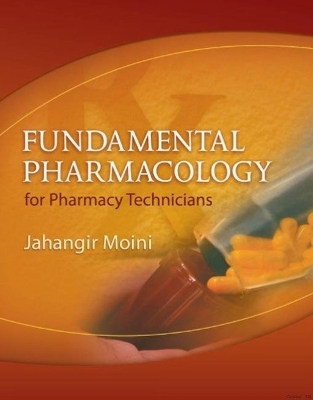
Fundamental Pharmacology for Pharmacy Technicians
Delmar Cengage Learning
978-1-4180-5357-4 (ISBN)
- Titel erscheint in neuer Auflage
- Artikel merken
Understanding how drugs act within the body and what they are used for is critical to the field of pharmacology. The pharmacy technician needs a working knowledge of the mechanism of action, indications, adverse effects, contraindications, and drug interactions of the medications they handle on a daily basis. Fundamental Pharmacology for Pharmacy Technicians provides this foundational knowledge. A review of anatomy and physiology is followed by a comprehensive discussion of the physiology of the body systems relative to the mechanism of action of specific drug classes. The pathophysiology of disease states is addressed to illustrate specific drug classes in the context of treatment options.
Dr. Moini is a Professor of Science at Eastern Florida State College. Formerly the Director of Allied Health Programs at Everest University, where he established the Medical Assisting Program and Associate Degree Program, Dr. Moini also served the Brevard County Health Department as an epidemiologist and health educator consultant, offering continuing education courses on pharmacology, medication errors, immunizations, and other important topics. Before coming to the United States, Dr. Moini spent nine years as an Assistant Professor at Tehran University Medical and Nursing School. An internationally published author of more than eight allied health textbooks, Dr. Moini is actively involved in helping students prepare for careers in various health professions, including pharmacy, nursing, and medical assisting.
Section I General Aspects of Pharmacology.
1. Introduction to Pharmacology, Drug Legislation, and Regulation.
2. Drug Sources and Dosage Forms.
3. Biopharmaceutics.
Section II Pharmacology Related to Specific Body Systems and Disorder.
4. Drug Therapy for the Nervous System: Antipsychotic and Antidepressant Drugs.
5. Drug Therapy for the Nervous System: Antianxiety and Hypnotic Drugs.
6. Drug Therapy for the Autonomic Nervous System.
7. Drug Therapy for Parkinsons and Alzheimer's Disease.
8. Drug Therapy for Seizures.
9. Anesthetic Drugs.
10. Drug Therapy for Musculoskeletal System.
11. Drug Therapy for Cardiovascular Disorder.
12. Antihypertensive Agents and Hyperlipidemia.
13. Anticoagulant Drugs.
14. Drug Therapy for Allergies and Respiratory Disorders.
15. Drug Therapy for Gastrointestinal Disorders.
16. Hormonal Therapy for Endocrine Gland Disorders.
17. Hormones of the Reproductive System and Contraceptives.
18. Diuretics.
Section III Pharmacology for Disorders Affecting Multi-body Systems.
19. Vitamins, Minerals, and Nutritional Supplements.
20. Antineoplastic Agents.
21. Analgesics.
22. Anti-infectives and Systemic Antibacterial Agents.
23. Antiviral, Antifungal, and Anti-protozoal Agents.
Section IV Pharmacology for Specific Populations.
24. Drug Therapy During Pregnancy and Lactation.
25. Drug Therapy for Pediatric Patients.
26. Drug Therapy in Geriatrics.
Appendix A: Case Studies.
Appendix B: Top 200 Drugs by Prescription.
Appendix C: Common Look-alike and Sound-alike Drugs.
Appendix D: Classifications of Drug Schedules in the United States and Canada.
Appendix E: Drug Dosage Calculations.
Appendix F: Immunization.
Appendix G: Specific Antidotes.
Appendix H: Reporting of Medical Errors.
Appendix J: Drugs that Should Not Be Crushed.
Appendix I: Drug/Food Interactions.
| Erscheint lt. Verlag | 29.10.2008 |
|---|---|
| Verlagsort | Clifton Park |
| Sprache | englisch |
| Maße | 217 x 275 mm |
| Gewicht | 1257 g |
| Themenwelt | Medizin / Pharmazie ► Medizinische Fachgebiete ► Pharmakologie / Pharmakotherapie |
| ISBN-10 | 1-4180-5357-0 / 1418053570 |
| ISBN-13 | 978-1-4180-5357-4 / 9781418053574 |
| Zustand | Neuware |
| Haben Sie eine Frage zum Produkt? |
aus dem Bereich



